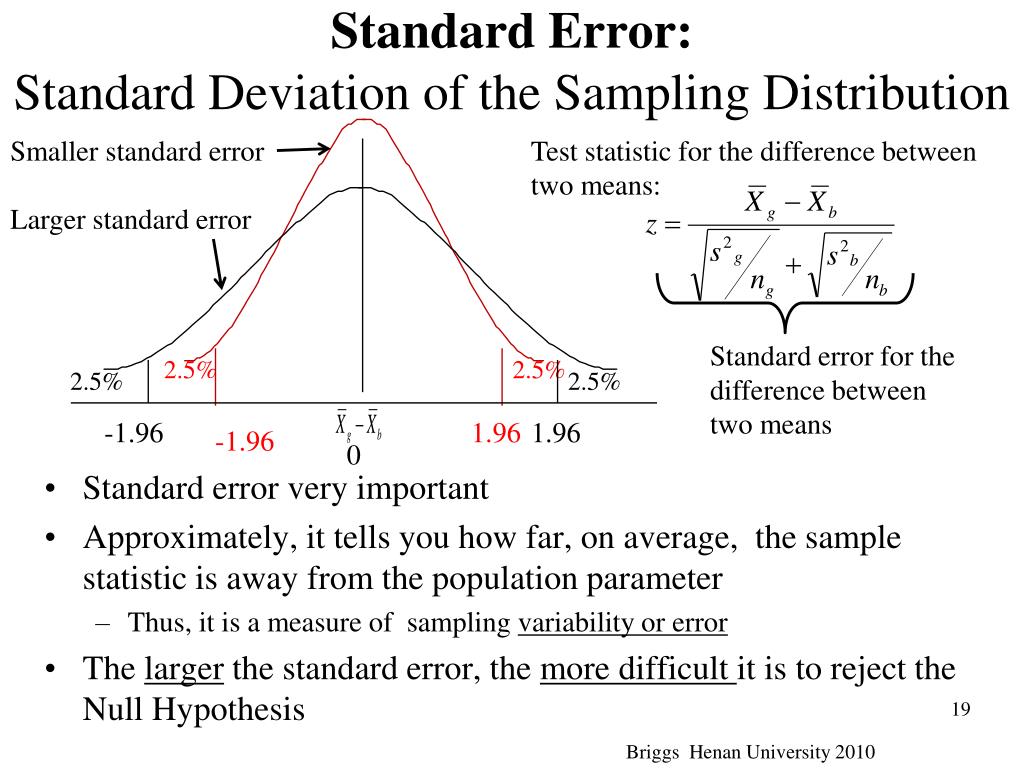Standard Error Standard Deviation | In statistics, the standard error is the standard deviation of the sample distribution. It is also called the standard deviation of the mean and is abbreviated as sem. Standard deviation is also known as root mean square deviation. The standard deviation of sample means, is called the standard error. The sample mean of a data is generally varied from the actual population mean. The standard deviation of this distribution, i.e. The temptation to introduce a math formula here is really high, but we can still do it without writing long formulae. If the statistic is the sample mean, it is called the standard error of the mean (sem). Standard deviation (sd) is the average deviation from the mean in your observed data. The standard deviation of sample means, is called the standard error. In statistics, the term standard error of a statistic refers to the estimate of the standard deviation of the sample mean from the true population mean. Standard deviation is also known as root mean square deviation. It is important to check that the confidence interval is symmetrical about the mean (the distance between the lower limit and the mean is the same as the distance between the mean and the upper limit). Let μ 4 = e ( x − μ) 4. It is also called the standard deviation of the mean and is abbreviated as sem. Suppose i have an excel an put random values (1 to 4) in 10 cells. Standard error is used to measure the statistical accuracy of an estimate. The standard error estimates the variability across multiple samples of a population. Standard deviation and standard error of the mean are both statistical measures of variability. The standard error is the approximate standard deviation of a statistical sample population. The sample mean deviates from the population and that deviation is known as standard error formula. The standard deviation of this distribution of sample means is the standard error of each individual sample mean. In sampling, the three most important. Standard error and standard deviation are both measures of variability: Standard error is used to measure the statistical accuracy of an estimate. The formula you gave in your question applies only to normally distributed data. Insert this widget code anywhere inside the body tag; Standard error measures the precision of the estimate of the sample mean. The accuracy of a sample that represents a population is known through this formula. The definition of the standard deviation states that it is the square root of the mean of the square of the deviation of all the values of a series derived from the arithmetic mean. Calculations for the control group are performed in a similar way. The formula you gave in your question applies only to normally distributed data. In statistics, the standard error is the standard deviation of the sample distribution. The standard error estimates the variability across multiple samples of a population. Standard deviation in statistics, typically denoted by σ, is a measure of variation or dispersion (refers to a distribution's extent of stretching or squeezing) between values in a set of data. A topic which many students of statistics find difficult is the difference between a standard deviation and a standard error. It is used to measure the amount of accuracy by which the given sample represents its population. Just to remind you of a basic math formula, sd = √ (variance). The sample mean of a data is generally varied from the actual population mean. Let θ ^ = s 2. The sample mean deviates from the population and that deviation is known as standard error formula. Standard deviation is defined as an absolute measure of dispersion of a series. For instance, usually, the population mean estimated value is the sample mean, in a sample space. It clarifies the standard amount of variation on either side of the mean. The standard deviation of this distribution, i.e. The lower the standard deviation, the closer the data points tend to be to the mean (or expected value), μ. The standard deviation is a measure of. Now, this is where everybody gets confused, the standard error is a type of standard deviation for the distribution of the means. Standard deviation is defined as an absolute measure of dispersion of a series. The standard error of the sample mean depends on both the standard deviation and the sample size, by the simple relation se = sd/√(sample size). If the statistic is the sample mean, it is called the standard error of the mean (sem). The standard error (se) of a statistic (usually an estimate of a parameter) is the standard deviation of its sampling distribution or an estimate of that standard deviation. Use the code as it is for proper working. Just to remind you of a basic math formula, sd = √ (variance). Then, the formula for the se of s 2 is: Descriptive statistics are used to describe the characteristics or features of a dataset. Let μ 4 = e ( x − μ) 4. Standard deviation is also known as root mean square deviation. The standard error is an important statistical measure and it is related to the standard deviation.

While the standard deviation of a sample depicts the spread of observations within the given sample regardless of the population mean, the standard error of the mean measures the degree of dispersion of sample means around the population mean standard error. While the standard deviation of a sample depicts the spread of observations within the given sample regardless of the population mean, the standard error of the mean measures the degree of dispersion of sample means around the population mean.
Standard Error Standard Deviation! The standard error of the mean is a method used to evaluate the standard deviation of a sampling distribution.
0 comments:
Post a Comment